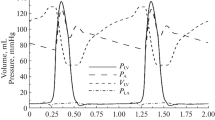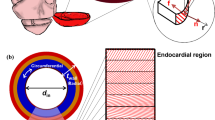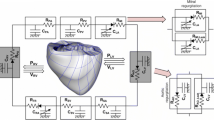Abstract
The relation between cardiac muscle mechanics and left ventricular (LV) pump function is simulated by a mathematical model. In the following article special attention is paid to the relation between LV pressure and LV volume on the one hand and the transmural distribution of sarcomere length and fiber stress on the other. The LV is simulated by a thick-walled cylinder composed of 8 concentric shells. The myocardial material is assumed to be anisotropic. The orientation and sequential activation of the muscle fibers across the LV wall are considered per shell. Twisting of the base with respect to the apex around the axis of the LV is simulated by rotation of the upper cross-sectional surface of the cylinder with respect to the lower one aroud the axis of the cylinder.
The model reveals that twisting of the LV is an important means to equalize transmural differences in sarcomere shortening and end-systolic fiber stress. When torsion is allowed, transmural differences in sarcomere shortening and end-systolic fiber stress are less than 18% and 16%, respectively. When torsion is prevented as in most of the models of LV-mechanics described in literature, these transmural differences increase up to 32% and 42%, respectively.
Similar content being viewed by others
References
Arts, M. G. J. A mathematical model of the dynamics of the left ventricle and the coronary circulation. Thesis, University of Limburg, The Netherlands, 1978.
Arts, T., and R. S. Reneman. Analysis of intramyocardial pressure (IMP). A model study.Bibl. Anat. 15:103–107, 1977.
Back, L. Left ventricular wall and fluid dynamics of cardiac contraction.Math. Biosci. 36:257–297, 1977.
Binkhorst, R. A., L. Hoofd, and A. C. A. Vissers. Temperature and force-velocity relationship of human muscles.J. Appl. Physiol. 42:471–475, 1977.
Durrer, D., R. Th. van Dam, G. E. Freud, M. J. Janse, F. L. Meyler, and R. C. Arzbaecher. Total excitation of the isolated human heart.Circulation 41:899–912, 1970.
Edman, K. A. P. and E. Nilsson. The mechanical parameters of myocardial contraction studied at a constant length of the contractile element.Acta Physiol. Scand. 27:205–219, 1968.
Gould, P., D. Ghista, and L. Brombolich. In vivo stresses in the human left ventricular wall: Analysis accounting for the irregular 3-dimensional geometry and comparison with idealised geometry analyses.J. Biomech. 5:521–539, 1972.
Hanna, W. T.. A simulation of human heart function.Biophys. J. 13:603–621, 1973.
Hill, A. V. A discussion on muscular contraction and relaxation: Their physical and chemical basis. Proc. R. Soc. London, Ser. B 137:40–87, 1950.
Hood, W. P. Jr., W. J. Thomson, C. E. Rackley and E. L. Rolett. Comparison of calculations of left ventricular wall stress in man from thin-walled and thick-walled ellipsoidal models.Circ. Res. 24:575–582, 1969.
Hort, W. Makroskopische und mikrometrische Untersuchungen am Myocard verschieden stark gefüllter linker Kammern.Vichows Arch. Pathol. Anat. 333:523–564, 1960.
Janz, R. F. and A. F. Grimm. Finite-element model for the mathematical behaviour of the left ventricle.Circ. Res. 30:224–252, 1972.
Janz, R. F. and A. F. Grimm. Deformation of the diastolic left ventricles: I. Non-linear elastic effects.Biophys. J. 13:589–704, 1973.
McHale, P. A. and J. C. Greenfield. Evaluation of several geometric models for estimation of left ventricular circumferential wall stress.Circ. Res. 33:303–312, 1973.
Mirsky, I. Left ventricular stresses in the intact human heart.Biophys. J. 9:189–208, 1969.
Mirsky, I.. Ventricular and arterial wall stresses based on large deformation analysis.Biophys. J. 13:1141–1159, 1973.
Pao, Y. C., E. L. Ritman, and E. H. Wood. Finite element analysis of left ventricular myocardial stresses.J. Biomech. 7:469–477, 1974.
Pao, Y. C., R. A. Robb, and E. L. Ritman. Plain-strain finite-element analysis of reconstructed diastolic left ventricular cross-section.Ann. Biomed. Eng. 4:232–249, 1976.
Pollack, G. H. and J. W. Krueger. Sarcomere dynamics in intact cardiac muscle.Eur. J. Cardiol. 4:53–65, 1976.
Rankin, J. S., P. McHale, C. E. Arentzen, D. Ling, J. C. Greenfield, and R. W. Anderzon. The three-dimensional dynamic geometry of the left ventricle in the conscious dog.Circ. Res. 39:304–313, 1976.
Sagawa, K. The ventricular pressure-volume diagram revisited.Circ. Res. 43:677–687, 1978.
Scher, A. M. and A. C. Young. The pathway of ventricular depolarisation in the dog.Circ. Res. 4:461–469, 1956.
Sonnenblick, E. H., D. Spiro, and T. S. Cotrell. Fine structural changes in heart muscle in relation to the length tension curve.Proc. Nat. Acad. Sci. USA. 49:193–200, 1963.
Spotnitz, H. M., E. H. Sonnenblick, and D. Spiro. Relation of ultrastructure to function in intact heart. Sarcomere structure relative to pressure-volume curves of intact left ventricles of dog and cat.Circ. Res. 18:49–66, 1966.
Streeter, D. D., H. M. Spotnitz, D. P. Patel, J. Ross, and E. H. Sonnenblick. Fiberorientation in the canine left ventricle during diastole and systole.Circ. Res. 33:656–664, 1973.
Streeter, D. D., R. N. Vaishnav, D. J. Patel, H. M. Spotnitz, J. Ross, and E. H. Sonnenblick. Stress distribution in the canine left ventricle during diastole and systole.Biophys. J. 10: 345–363, 1970.
Suga, H. and K. Yamakoski. Left ventricle as a compression pump.Eur. J. Cardiol. 4:97–103. 1976.
Ter Keurs, H. E. D. J., T. Iwazumi, and G. H. Pollack. Sarcomere length-tension relation in skeletal muscle.J. Gen. Physiol. 27:565–592, 1978.
Wong, A. Y. K. and P. M. Rautoharju. Stress distribution within the left ventricular wall approximated as a thick ellipsoidal shell.Am. Heart J 75:649–661, 1968.
Yoran, C., J. W. Covell, and J. Ross. Structural basis for the ascending limb of left ventricular function.Circ. Res. 32:297–303, 1973.
Author information
Authors and Affiliations
Additional information
Supported by the Foundation for Medical Research FUNGO, which is subsidized by the Netherlands organization for the Advancement of Pure Research.
Rights and permissions
About this article
Cite this article
Arts, T., Reneman, R.S. & Veenstra, P.C. A model of the mechanics of the left ventricle. Ann Biomed Eng 7, 299–318 (1979). https://doi.org/10.1007/BF02364118
Issue Date:
DOI: https://doi.org/10.1007/BF02364118




